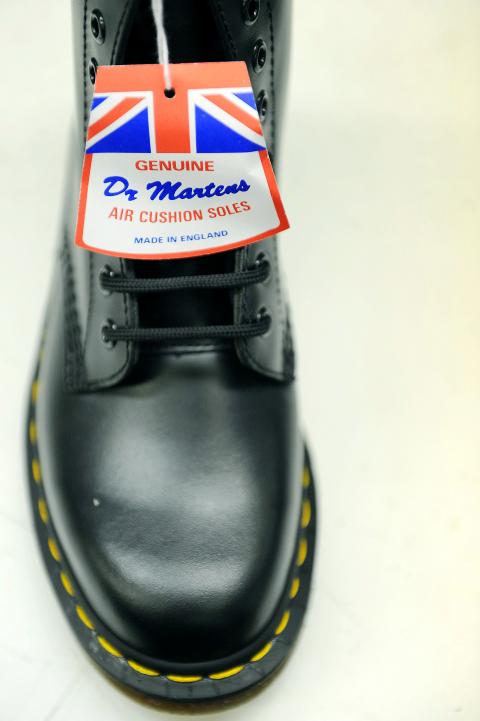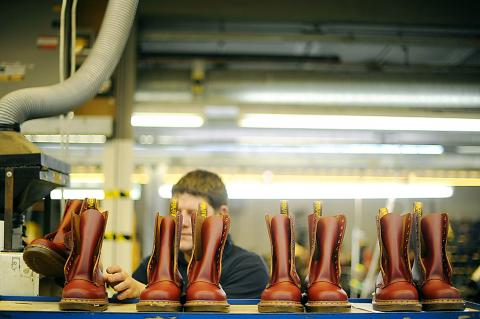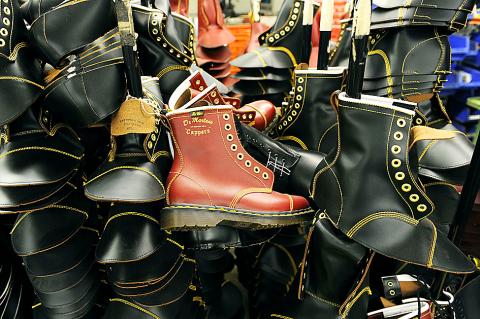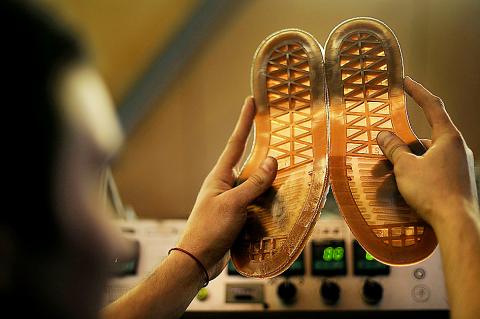Dr Martens boots were first introduced into the UK 50 years ago, a half-century that has seen the country transformed, as musical movements have emerged and declined, and fashions come and gone. Yet DMs have been the footwear of choice for everyone from punks to policemen, skinheads to socialists.
They may only be boots, but somehow Dr Martens have left a hefty footprint on style, music and politics. Which would probably have surprised Klaus Martens, the young German army doctor who created the original design. The story goes that Martens set about creating a boot that had an air-cushioned sole after injuring his ankle skiing. His sole provided comfort as well as absorbing impact from walking and running.
For the first few years after their introduction to Britain, Dr Martens were very much working men’s boots, worn in factories and by postmen. According to Martin Roach, author of the definitive history of DMs, Doctor Martens: The Story of an Icon, it was not until Pete Townshend, wind-milling guitarist and songwriter with The Who, wore them in around 1966 that they became fashionable. Townshend recalls buying DMs because he was tired of the foppish clothes that were so popular during the 1960s. “I was sick of dressing up as a Christmas tree in flowing robes that got in the way of my guitar playing,” he says, “so I thought I’d move on to utility wear.” The air-cushioned soles helped him bounce around on stage, and wearing the boots, Townshend explained, reminded him of the working-class surroundings in which he had grown up.

Photos: AFP
Having helped catapult Dr Martens into fashion in the 1960s, Townshend was then instrumental in helping create one of the defining images from 1970s popular culture, with 1975 rock opera Tommy featuring Elton John in an outsized pair of DM boots. The boots stand 1.3m high and John had to wear them attached by calipers that allowed him to move as if he were on stilts. Today the boots are on display in Northampton Museum, which has the largest shoe collection in the world.
By the 1970s Dr Martens had been taken up by a cluster of subcultures all intent on brandishing their individuality but all of which made DMs part of their uniform. Mods and glam rockers, psychobillies and goths all adopted the boots, but it was members of the emerging skinhead movement who would be the most feared wearers. Gavin Watson was a teenage skinhead growing up in High Wycombe near London. He was also an avid photographer, and his images from the period, many showing shaven-headed young men in gleaming Dr Martens, are compelling and disturbing. “I was 12 when I bought my first eight-hole DMs,” Watson said. “And the rule was that you had to christen them by kicking someone with them. It didn’t matter who, and if you got some blood on them that was even better.”
It was because of the actions of some skinheads that Dr Martens became associated with violence. Watson recalls: “The way we cut off the leather at the front to reveal the steel caps — those boots were seen as weaponry and you felt safe wearing them.”

Photos: AFP
As a young Asian boy growing up during that time, I was both attracted to and repelled by Dr Martens. I coveted them hugely and envied my older brother who owned a pair that he would place next to his bed so as to be able to go to sleep gazing at them. And yet the association with skinheads and racists was so strong that if I saw anyone wearing the eight-hole or, even worse, the 14-hole boot, I would walk warily past them and assume that they meant me harm.
And yet the irony was that even as the DM was being co-opted by skinheads — only a minority of whom were racist and violent — the boots were also being worn by the police they were clashing with. “When I joined the police in 1978 Dr Martens were a popular choice of shoe-wear,” recalls Mick Clyne. “I had a black pair with yellow stitching — but I had to use black boot polish to darken the yellow for when we were on night patrol.”
Dr Martens even managed to step inside the UK’s parliament, when veteran Labour politician Tony Benn was photographed wearing them there. When I met him in his west London home Benn, 85, was wearing black DM shoes. “My sons told me about Dr Martens back in the 1970s and I found they were very comfortable,” he said. “I have been wearing them ever since.”

Photos: AFP
Benn is among the oldest wearers of Dr Martens, but the boots are finding a new generation of fans. These days they are as likely to be worn by models such as Agyness Deyn and “celebrities” such as Pixie Geldof as they are by rock stars. Fifty years on, the enduring appeal of DMs is that, despite all the success, the brand remains unshakably cool. Dr Martens flogged a million boots ... but never sold its sole.

Photos: AFP

June 9 to June 15 A photo of two men riding trendy high-wheel Penny-Farthing bicycles past a Qing Dynasty gate aptly captures the essence of Taipei in 1897 — a newly colonized city on the cusp of great change. The Japanese began making significant modifications to the cityscape in 1899, tearing down Qing-era structures, widening boulevards and installing Western-style infrastructure and buildings. The photographer, Minosuke Imamura, only spent a year in Taiwan as a cartographer for the governor-general’s office, but he left behind a treasure trove of 130 images showing life at the onset of Japanese rule, spanning July 1897 to

One of the most important gripes that Taiwanese have about the Democratic Progressive Party (DPP) is that it has failed to deliver concretely on higher wages, housing prices and other bread-and-butter issues. The parallel complaint is that the DPP cares only about glamor issues, such as removing markers of Chinese Nationalist Party (KMT) colonialism by renaming them, or what the KMT codes as “de-Sinification.” Once again, as a critical election looms, the DPP is presenting evidence for that charge. The KMT was quick to jump on the recent proposal of the Ministry of the Interior (MOI) to rename roads that symbolize

On the evening of June 1, Control Yuan Secretary-General Lee Chun-yi (李俊俋) apologized and resigned in disgrace. His crime was instructing his driver to use a Control Yuan vehicle to transport his dog to a pet grooming salon. The Control Yuan is the government branch that investigates, audits and impeaches government officials for, among other things, misuse of government funds, so his misuse of a government vehicle was highly inappropriate. If this story were told to anyone living in the golden era of swaggering gangsters, flashy nouveau riche businessmen, and corrupt “black gold” politics of the 1980s and 1990s, they would have laughed.

In an interview posted online by United Daily News (UDN) on May 26, current Chinese Nationalist Party (KMT) Chairman Eric Chu (朱立倫) was asked about Taichung Mayor Lu Shiow-yen (盧秀燕) replacing him as party chair. Though not yet officially running, by the customs of Taiwan politics, Lu has been signalling she is both running for party chair and to be the party’s 2028 presidential candidate. She told an international media outlet that she was considering a run. She also gave a speech in Keelung on national priorities and foreign affairs. For details, see the May 23 edition of this column,